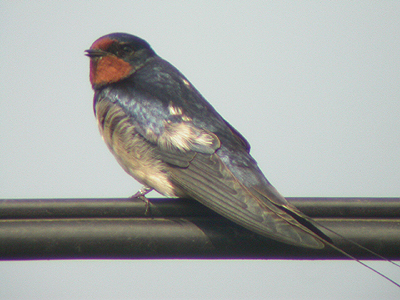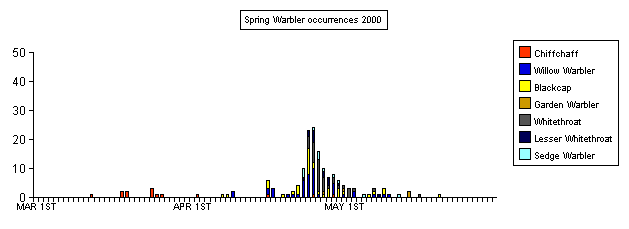

| Eakring Birds | ||
| Summer migrant arrival/departure dates 1998-2012 | ||
 |
Trying to break the
earliest and latest recorded arrival and departure dates
for our traditional Summer and Winter migrants, are a key
aspect of bird watching any local patch. Eakring is no exception, with records of all migrant arrivals dating back well over ten years to 1998. Similarly, the recording of visible migration through the area, makes up most of the bird watching year at Eakring. Movements can be detectable throughout a much longer portion of the year than many realise, with numbers peaking in both Spring and Autumn. By 2010, well over 250 000 birds of a selected 56 species of the most regular migrant species have been counted moving through here. |
|
| .... | ||
| As is well
known, weather conditions at the source of a bird's
migration, then anywhere on the journey from that source
to the breeding site, are often critical in determining
the arrival of migrants during the Spring. Birds can meet
bad weather anywhere on their journey north, resulting in
them becoming grounded and subsequently producing later
first dates. Since 1998, years with favourable weather
leading to early arrivals include 2000, 2003 and 2007,
with several earliest arrival records still remaining to
this day. On the whole, many species have been remarkably consistant in their arrival dates over the years. Whitethroat is a particularly good example of this, with arrivals occurring between April 21st and 24th no less than nine times in 13 years, whilst Spotted Flycatcher has shown considerable variation in it's arrival dates here. |
||
| .... | ||
 |
||
| .... |
| The area's
best ever period of migrant arrivals took place from
April 22-30th 2000 and is represented in the above graph
which shows all warbler arrivals in the area. After very
few new migrants on the 21st, north-easterly winds and
heavy rain brought down a number of migrants including 33
Whitethroats, 29 Willow Warblers, 23 Blackcaps, 13 Lesser
Whitethroats, 11 Wheatears, nine Sedge Warblers, three
Chiffchaffs, two Whinchats and single Reed Warbler and
Grasshopper Warbler. Insufficient habitat, means many migrants are restricted in numbers and large overnight arrivals are rare. However, migrant warbler counts, although low in comparison with other sites in the county, still reflect occurrence trends across Nottinghamshire as a whole. An overnight arrival of say ten Willow Warblers here, would probably mean that across the county a major event had taken place. |
| .... | |||||||||||||||||||||||||||||||||||||||||||||||||||||||||||||||||||||||||||||||||||||||||||||||||||||||||||||||||||||||||||||||||||||||||||||||||||||||||||||||||||||||||||||||||||||||||||||||||||||||||||||||||||||||||||||||||||||||||||||||||||||||||||||||||||||||||||||||||||||||||||||||||||||||||||||||||||||||||||||||||||||||||||||||||||||||||||||||||||||||||||||||||||||||||||||||||||||||||||||||||||||||||||||||||
| Summer
migrant arrivals by year ....... Current
earliest arrival dates are highlighted in red - latest in
blue |
|||||||||||||||||||||||||||||||||||||||||||||||||||||||||||||||||||||||||||||||||||||||||||||||||||||||||||||||||||||||||||||||||||||||||||||||||||||||||||||||||||||||||||||||||||||||||||||||||||||||||||||||||||||||||||||||||||||||||||||||||||||||||||||||||||||||||||||||||||||||||||||||||||||||||||||||||||||||||||||||||||||||||||||||||||||||||||||||||||||||||||||||||||||||||||||||||||||||||||||||||||||||||||||||||
|
|||||||||||||||||||||||||||||||||||||||||||||||||||||||||||||||||||||||||||||||||||||||||||||||||||||||||||||||||||||||||||||||||||||||||||||||||||||||||||||||||||||||||||||||||||||||||||||||||||||||||||||||||||||||||||||||||||||||||||||||||||||||||||||||||||||||||||||||||||||||||||||||||||||||||||||||||||||||||||||||||||||||||||||||||||||||||||||||||||||||||||||||||||||||||||||||||||||||||||||||||||||||||||||||||
| .... | |||||||||||||||||||||||||||||||||||||||||||||||||||||||||||||||||||||||||||||||||||||||||||||||||||||||||||||||||||||||||||||||||||||||||||||||||||||||||||||||||||||||||||||||||||||||||||||||||||||||||||||||||||||||||||||||||||||||||||||||||||||||||||||||||||||||||||||||||||||||||||||||||||||||||||||||||||||||||||||||||||||||||||||||||||||||||||||||||||||||||||||||||||||||||||||||||||||||||||||||||||||||||||||||||
| The departure
of most Summer migrant species is a more lengthier
process. A general exception to this rule is the Cuckoo,
a species which disappears almost overnight around
mid-June. Records of adults after the middle of June have
been non-exsistant to date. Juvenile Warblers tend to
linger, sometimes for days before resuming southward
movement and good numbers can at times, build up in a
single area, though there is a considerable turn-over in
the number of different individuals. One of the best sites to watch the movement of many species, is at Red Hill, to the west of Eakring Flash. Here, it is possible to have large numbers of migrant Hirundines, the odd Tree Pipit in with Meadow Pipits overhead and occasional Warblers moving quickly along the hedgerows and in the trees. Good days can also see Wheatear or Redstart around the same area. Particularly favoured areas for migrants are the old hedge at Eakring Flash, Oil Bore Holes in Eakring village, the Kersall Pond area and the north-eastern corner of Penny Pasture Common at Eakring Meadows. All four sites can attract good numbers of migrants and are checked daily during the Autumn. Elder bushes are a particular favourite for several species. All of the Reed Warbler records from Eakring Flash, have come from the Elders situated within the old hedge which runs alongside The Beck. Elders are again particularly favoured at Penny Pasture Common. |
|||||||||||||||||||||||||||||||||||||||||||||||||||||||||||||||||||||||||||||||||||||||||||||||||||||||||||||||||||||||||||||||||||||||||||||||||||||||||||||||||||||||||||||||||||||||||||||||||||||||||||||||||||||||||||||||||||||||||||||||||||||||||||||||||||||||||||||||||||||||||||||||||||||||||||||||||||||||||||||||||||||||||||||||||||||||||||||||||||||||||||||||||||||||||||||||||||||||||||||||||||||||||||||||||